N EW SL ET TER Term: Aut umn | Issue 2 | Dat e: 22 November 2024 W ELCOM E FROM JO WALKER AND JENNIE FORDE, M ATHS HUB LEADS The school year is well underway, as are the majority of the Work Groups that we run. We are still recruiting for the following Work Groups so please do sign up if you are interested or pass on the information to colleagues: PRIM ARY AND EARLY YEARS Specialist Kn ow ledge f or Teach in g of M at h em at ics, Ear ly Year s Teach er s Specialist Kn ow ledge f or Teach in g of M at h em at ics, Pr im ar y Teach in g Assist an t s Specialist Kn ow ledge f or Teach in g of M at h em at ics ? Pr im ar y Teach er s SECONDARY Specialist Kn ow ledge f or Teach in g M at h em at ics ? Secon dar y Ear ly Car eer Teach er s Ph ase 1 Specialist Kn ow ledge f or Teach in g M at h em at ics ? Secon dar y Non -Specialist Teach er s Resear ch an d In n ovat ion Wor k Gr ou p - Secon dar y Over seas Teach er s POST 16 Developin g Cor e M at h s Pedagogy Developin g A Level Pedagogy CROSS PHASE Year s 5-8 Con t in u it y Cr oss Ph ase ? Su ppor t in g low at t ain er s t o ach ieve a L2 qu alif icat ion in m at h em at ics ITT Par t n er sh ips
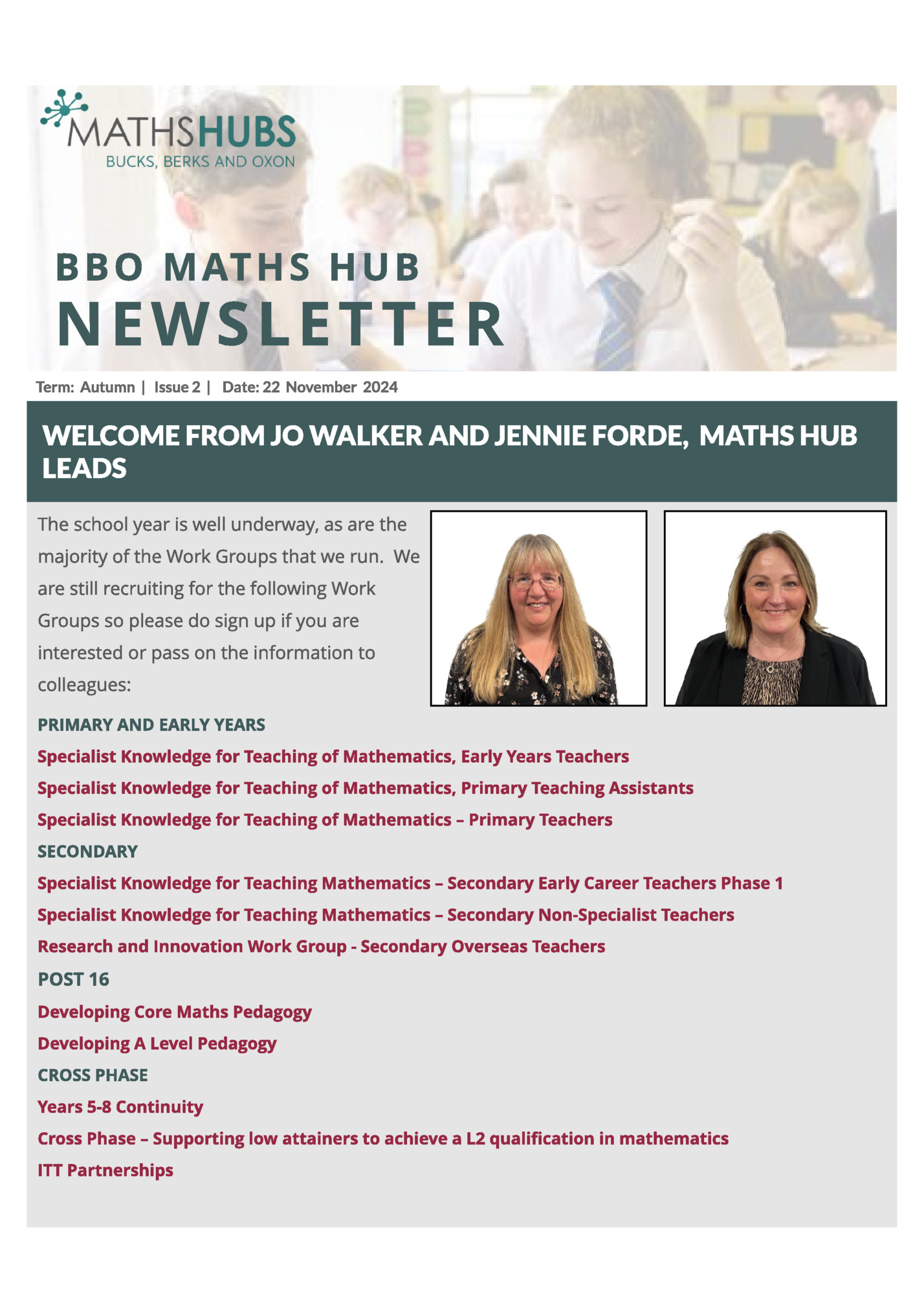
At the start of this month, the Local Leaders of Maths Education, who lead our Work Groups and collaborate closely with schools in our region, came together to discuss the direction of the BBO Maths Hub for this academic year. The central theme of the meeting was Collaborative Professionalism. This focus was inspired by case studies from local schools and feedback from last year ? work groups, which underscored the critical role of s collaboration in driving meaningful change and ensuring consistency within teams. By fostering a culture of shared learning, this approach empowers teachers to benefit from one another ? expertise and ultimately supports the delivery of high-quality, seamless education s for all students, regardless of which teacher they have. On 10th November, Schools Week published the following article, asking ? teacher Is collaboration ? worth it? , concluding that teachers overwhelmingly value the opportunity to ?? participate in high quality collaborative experiences. The article states that ? a recent In study, teachers expressed that one of the key facets of peer collaboration they particularly value is the openness that comes without accountability pressures? At the BBO Maths Hub, . we are exploring how our Work Groups and work with schools and teachers supports a move towards that ? golden cell of professional collaboration, where teachers have strong relationships, trust each other and feel free to take risks and make mistakes? as described in , Collaborative Professionalism (Hargreaves and O? Connor 2018).
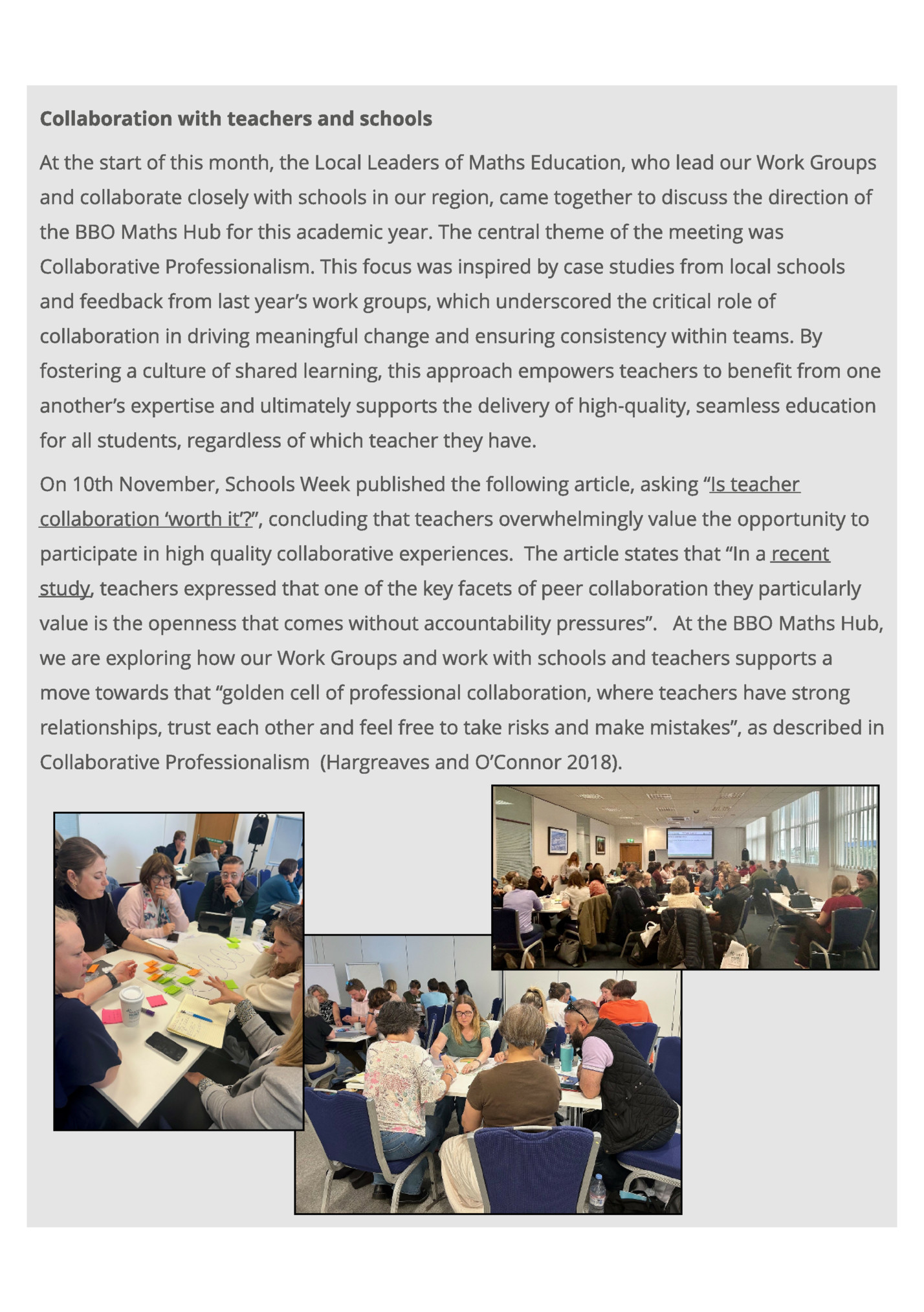
used in Maths Hubs projects, with collaboration built in on every level. Work Group participants meet regularly during the year to collaborate with peers from other local schools, to share ideas and develop their own practice. The learning and collaboration doesn? stop there as participants then work with colleagues to establish approaches across t their department or school, then meet back in the Work Group to share experiences and discuss next steps. Each Work Group is usually part of a Network Collaborative Project (NCP) which supports the Work Group Lead and aims to ensure that projects across the country can benefit from any lessons learnt. If you have yet to participate, contact us to find out how to be part of this exciting network of teachers and schools working together to develop maths education for all students. EEF Im plem en t at ion Gu idan ce The EEF have updated their advice for how to effectively implement change in schools. This applies at all levels of school development from the individual department through to the whole school or MAT, and is invaluable in supporting school leaders as they lead their school in making change. See the report here. Support for school leaders in all phases is available through the Maths Hub: Pr im ar y Maths Leads in schools on the Mastery journey ? strand in Sustaining Secon dar y teachers leading on developing Mastery ? strand in Sustaining Secon dar y Head of Depar t m en t ? Secondary Subject Leaders Community (For any secondary) Secon dar y Headt each er s, SLT an d Heads of depar t m en t w ebin ar lead by NCETM, for schools on the mastery journey. The foci will be : - What is teaching for mastery in maths and why is it needed? - How a work group functions and why is it a successful model. - Barriers to implementation and how senior leaders can help. The webinar will take place on Monday 2 December, 4 to 4.30 pm. The link to attend is : Zoom link
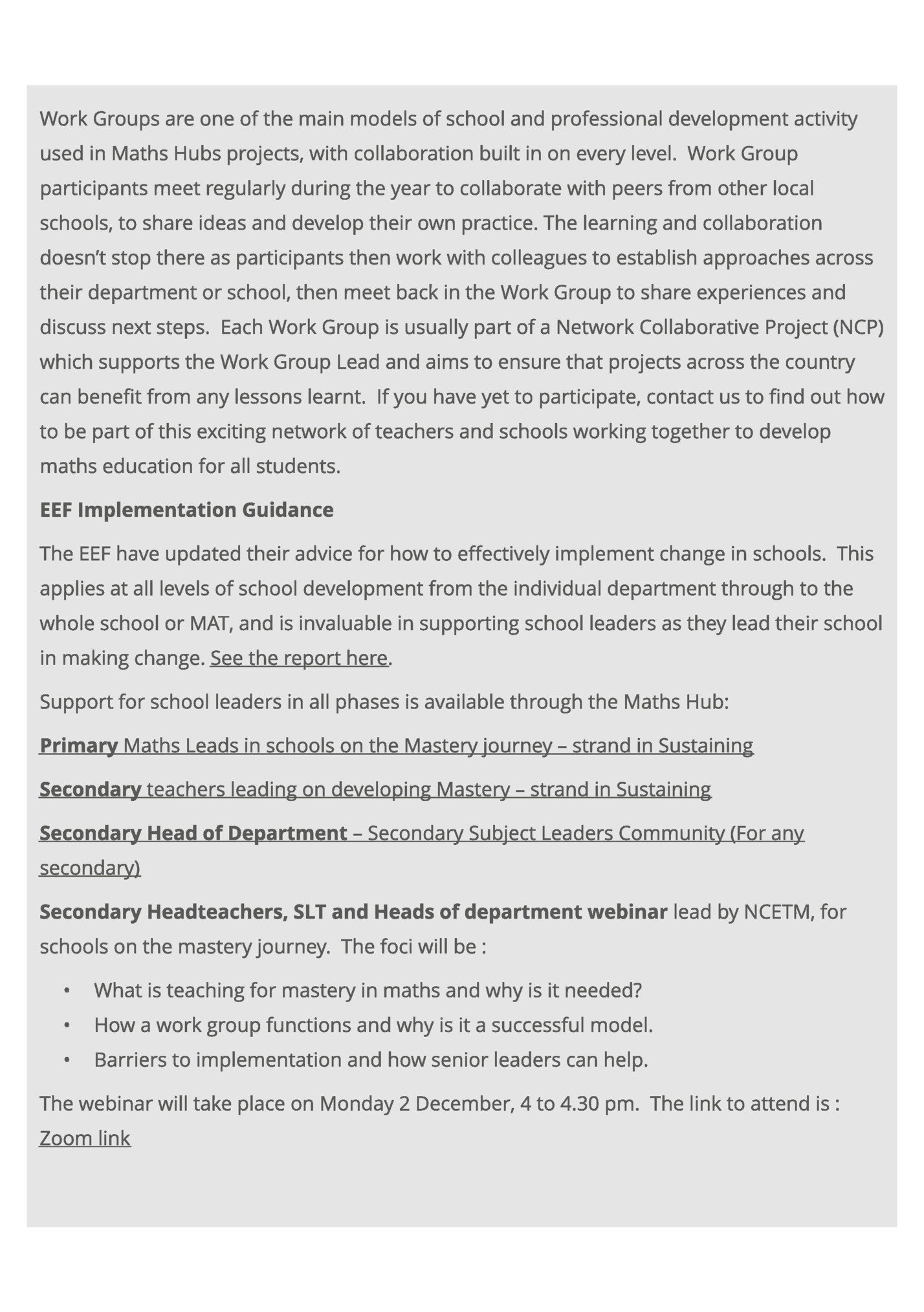
learning to ensure that every student receives a high-quality education. We recognise the unique needs of each school, working together with schools to develop our work to support local needs. If our current support offerings do not align with your development priorities, or if you would like guidance on selecting the most suitable work group, please do not hesitate to reach out to the hub. We are here to assist you in finding the right resources for your school's success. Local Leader s of M at h s Edu cat ion We are also seeking passionate and skilled Local Leaders of Mathematics Education to join our team and expand our support network to more schools. Recruitment for the 2025?2026 academic year will commence after the holiday season, so we encourage you to stay alert for opportunities that could benefit you and your school. Our next newsletter will be in the New Year so, although it feels a little early to say, from us and all of the BBO team, we hope you have a good half term and a restful and fun Christmas Holiday. CONTENTS Page 5 : PRIM ARY ARTICLE - M u sic an d M at h s - It 's m or e t h an ju st f r act ion s Page 7 : SECONDARY ARTICLE - Secon dar y Su bject Leader s Com m u n it y Page 9 : POST 16 ARTICLE - Wh y Sh ou ld Sch ools Of f er Cor e M at h s? Page 11 : PRIM ARY WORK GROUPS Page 13 : SECONDARY WORK GROUPS Page 16 : CROSS PHASE WORK GROUPS Page 17 : POST-16 WORK GROUPS Page 18 : ALL WORK GROUPS AND OPPORTUNITIES FOR 2024/ 25 Page 20 : NCETM NEWS AND FEATURES If you are having trouble opening the links in this newsletter in the online viewer please click on the book icon on the bottom right to disable page turn transitions
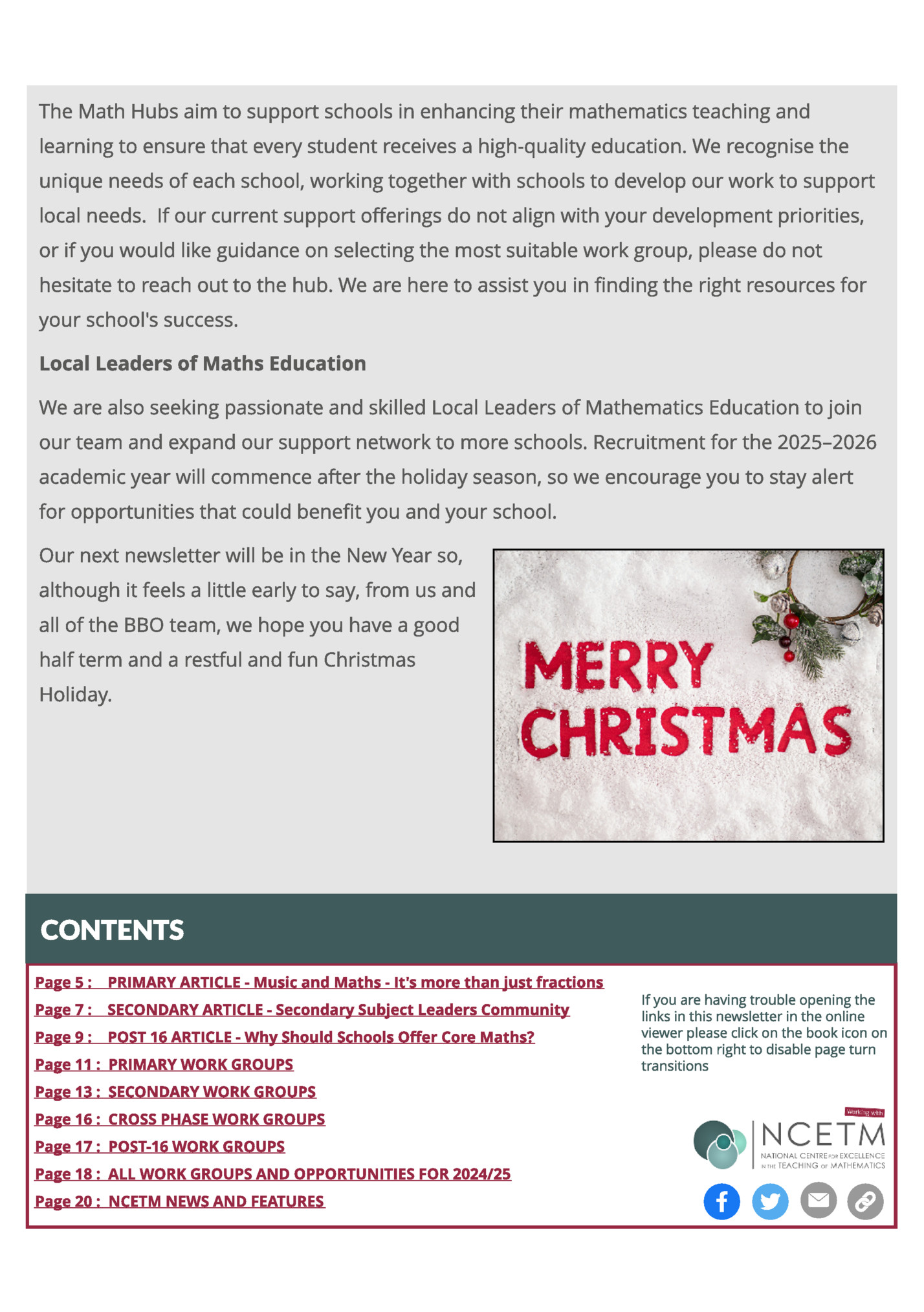
PRIM ARY Tin a Har vey, Pr im ar y M ast er y Specialist The connection between music and mathematics runs deep, intertwining in numerous ways to create harmony, rhythm, and structure. At its core, both disciplines share fundamental principles such as patterns, ratios, and proportions. This essay will explore some of the relationships between music and mathematics by examining how mathematical principles influence scales, intervals, rhythm, harmony, and may even influence the emotional impact of music. Music and mathematics have been intrinsically connected for centuries, one of the most prominent connections being, the fraction. Fractions are deeply embedded in the structure of music, influencing rhythm, time signatures and note durations, allowing musicians to create intricate patterns of notes. One of the most obvious links between fractions and music is in rhythm. Rhythm in music is essentially the timing of sounds and is organisation into beats. These beats can be divided into smaller units, creating patterns that musicians follow. In Western music, rhythms are commonly structured around time signatures, which are expressed as fractions. Beats per bar are notated as fractions, as the time signature specifies how many notes and of what value are contained in each bar. These are further divided and sub divided to create the rhythm. Interestingly, many cultures refer to a bar as a measure and use the term ? quarter note?for a crotchet. This is a fraction, as it represents one-fourth of a whole note. Similarly, eighth notes represent one-eighth of a whole note and so on. In this sense, fractions define the length of musical notes, and musicians must divide measures or bars into fractional components. A measure may be composed of a combination of different fractions of notes, which together make up a whole. Musicians rely on their understanding of fractions to ensure they play each note for the correct duration. This ability to divide into precise units is fundamental to the performance and composition of music. It is worth noting, at this point, that some divisions are easier than others. 4/4 or common time is far more straightforward to divide than music written in unusual or complex time signatures. An irregular time signature cannot be divided evenly into beats per the bar. For example, they may appear in sheet music as 5/4, 11/4, 5/8 or other combinations. The fractional nature of these time signatures plays a key role in shaping the rhythm of the music. Musicians must not only understand the number of beats per bar but also recognize how long each beat lasts. This requires an intuitive understanding of fractions. Rhythms in music rely on mathematical calculations to ensure precision in timing and structure. Composers use these note values to create patterns and organize the flow of music. By understanding the mathematical basis of rhythm, musicians can accurately interpret and perform the timing required in a musical piece. The concept of harmony in music is also rooted in mathematical relationship. When multiple notes are played together to create chords, the intervals between these notes follow specific mathematical ratios. The construction of scales is also based on mathematical formulas that dictate the sequence of intervals between each note. David Kung? (2019) exploration of scales and intervals highlights how these fundamental elements s of music are not only essential for creating melodies and harmonies but are also deeply rooted in mathematical relationships. An interval in music refers to the distance between two pitches. Intervals can be described in various ways but are often categorised by their size or the number of scale degrees they cover. Each interval can be represented as a frequency ratio, which defines the relationship between two pitches. For instance, a perfect octave has a frequency ratio of 2:1.
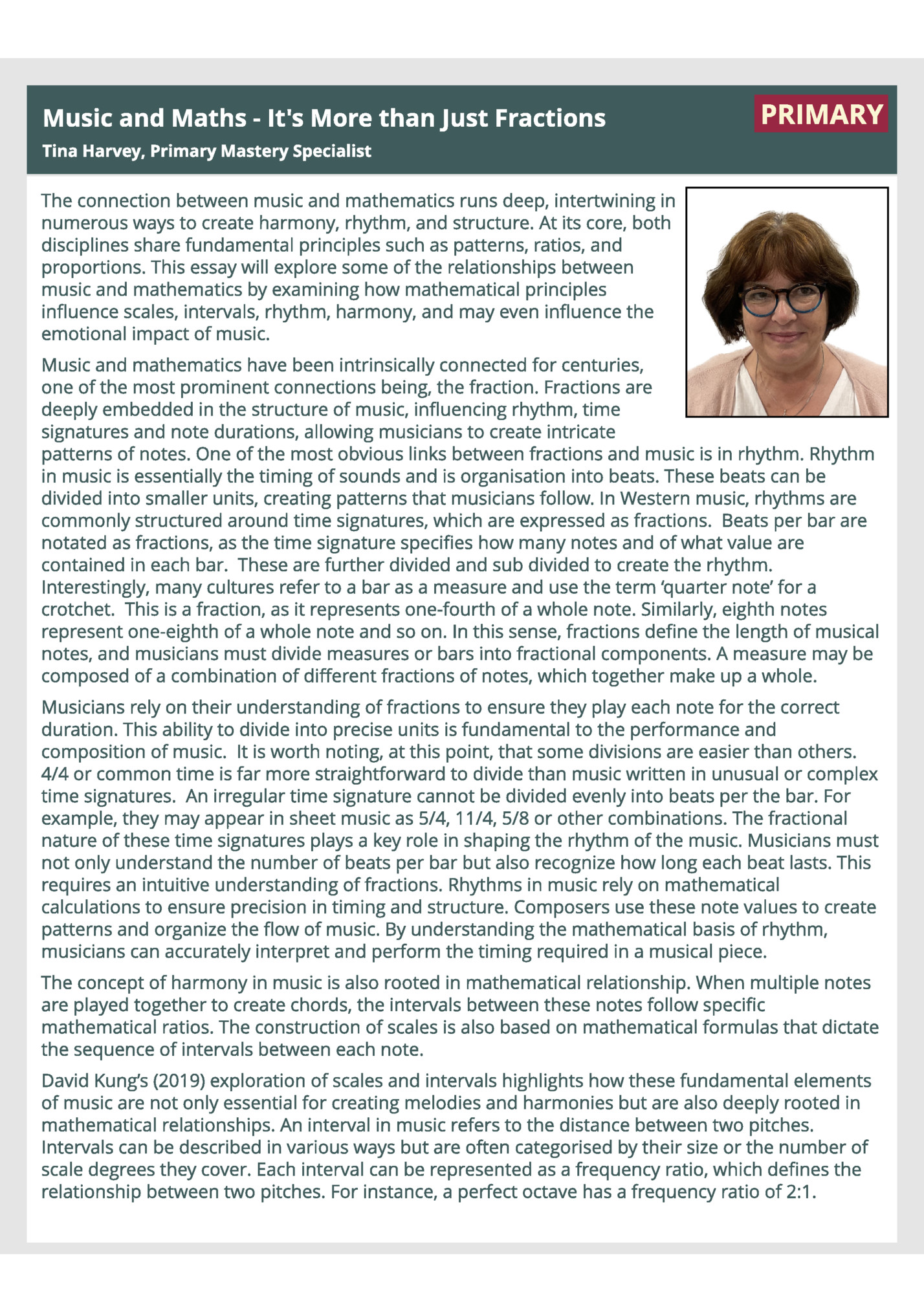
PRIM ARY Tin a Har vey, Pr im ar y M ast er y Specialist Furthermore, scales are also built using specific intervals, and understanding this construction is vital for any musician, as they contain a sequence of whole and half steps. The major scale, for example, follows the pattern of whole and half steps: W-W-H-W-W-W-H (where W represents a whole step and H represents a half step). This pattern creates a series of intervals that define the scale's unique sound. By understanding these intervals, musicians can not only play melodies but also compose harmonies that align with the tonal framework of the scale. The concept of intervals is not the same across cultures. While Western music primarily uses a twelve-tone system, which divides an octave into twelve equal parts, many other cultures apply different tuning systems that create unique note structures. Kung (2019) The emotional impact of intervals is a significant aspect of music that extends beyond mathematical relationships. Different intervals can evoke various feelings and moods. Understanding these emotional associations allows composers and performers to use intervals intentionally to shape the listener 's experience. The exploration of scales and intervals highlights the intricate connections between mathematics and music. Ultimately, the study of intervals is not just an academic exercise; it is a gateway to unlocking music, thereby enabling musicians to communicate. Another fascinating mathematical link is that of the Fibonacci sequence, which continually inspires composers across various genres. The Fibonacci sequence is a series of numbers where each number is the sum of the two preceding ones, starting from 0 and 1. The sequence looks like this: 0, 1, 1, 2, 3, 5, 8, 13, 21, and so on. This sequence is significant because it appears in various natural phenomena and patterns, from the arrangement of leaves on a stem to the branching of trees and the patterns of shells. In music composition, the Fibonacci sequence can be used to influence bar length or rhythmic patterns. J ohann Sebastian Bach? compositions are often noted for how they s reflect the Fibonacci sequence in their formal structure and the development of motifs (a short musical idea that occurs often in a piece of music). The Fibonacci sequence can be seen as a powerful tool in music composition, offering a mathematical foundation that can enhance structural integrity and artistic appeal. By applying these concepts, composers can create works that resonate with listeners on a deeper level, reflecting the natural patterns in nature with proportions that underpin both music and the world around us. (Harkleroad 2009) The intricate relationship between music and mathematics is rich and spans centuries and cultures. From the fundamental properties of sound and the mathematical relationships of intervals and scales to the emotional impact of harmony and rhythm, the relationship between these two disciplines is easy to see. The connection between music and mathematics is multifaceted, with mathematics acting as a foundation upon which musical expression is built. Through rhythm, harmony and structure, mathematics incorporates every aspect of music. Bibliogr aph y Carter, N. (2016) Music theory: From absolute beginner to expert [Audio Book]. Unknown publisher. Harkleroad, L. (2009) The math behind the music. New York: Cambridge University Press. Kung, D. (2019) How music and mathematics relate [Audio Book]. The Great Courses. Sulzer, D. (2021) Music, math, and mind: The physics and neuroscience of music. New York: Columbia University Press
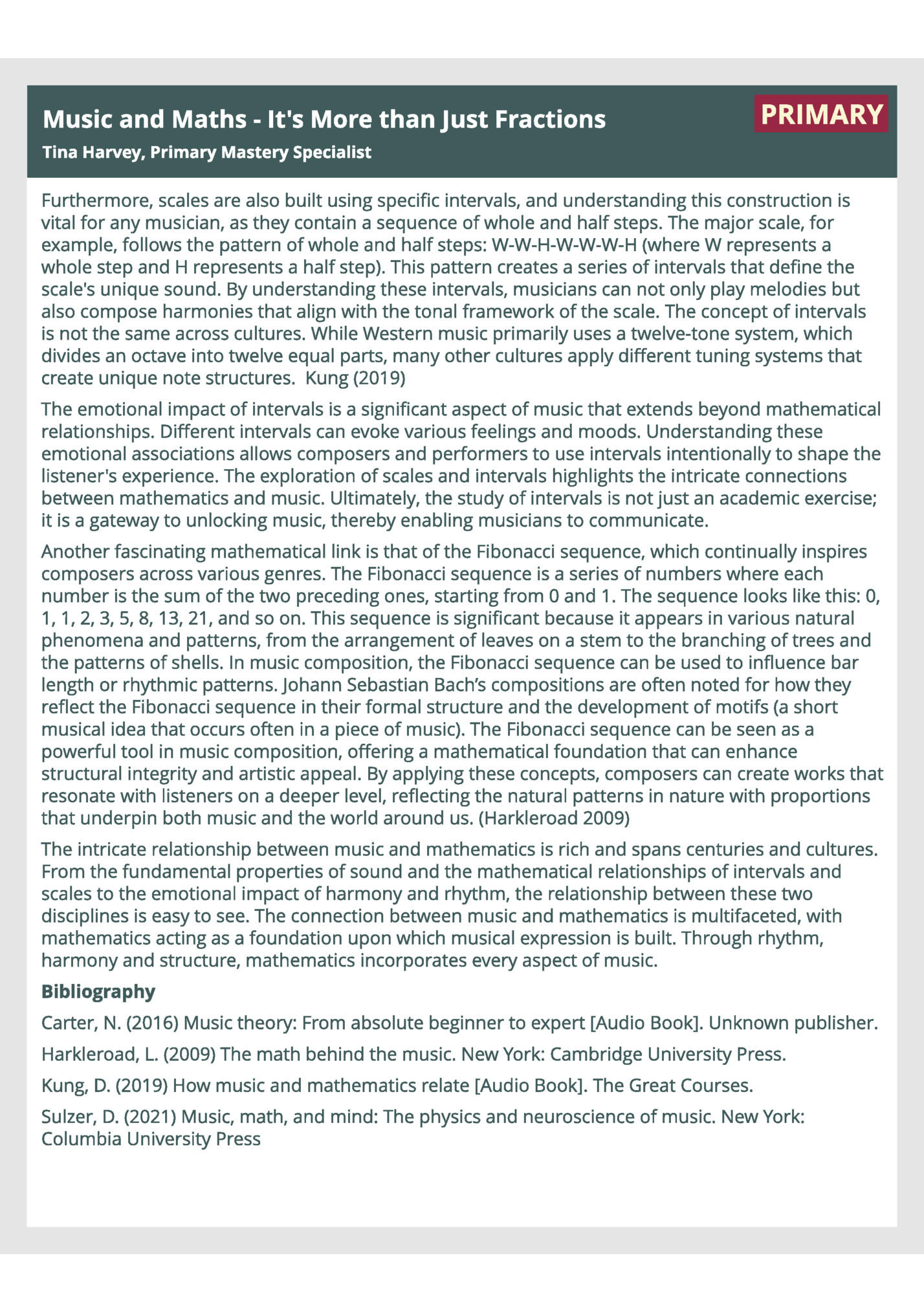
Lu cy Dasgu pt a, Secon dar y M ast er y Specialist SECONDARY COM M UNITY The BBO Secondary Subject Leaders?Community is about to begin its third year. 25 Heads of Mathematics departments across the hub region will be meeting up for three face to face days during the year. So? Wh y does t h e Secon dar y Su bject Leader s?Com m u n it y exist ? Wh y do Heads of M at h s k eep com in g back ? When I first became a head of maths (possibly before some of you were born!) two or three times a year, maths leaders from across the county would meet for days of CPD led by the Local Authority Maths Advisory team. I found the meetings invaluable, first to learn from more experienced leaders and later to have time, away from school to consider the input from the advisors and discuss it with peers. It can be lonely to be a maths subject leader in a school. You are typically the most senior member of staff with an understanding of specific mathematical pedagogy, and you have a lot of significant decisions to make. Not only is it your responsibility to consider any whole school initiatives through a mathematical pedagogical lens but you also need to keep up, digest and translate into actions any government initiatives for your team. I have been lucky enough to build a network of colleagues who are now maths leaders. They have proved their worth every year, but they were especially useful when we found ourselves grappling with TAGs! Fingers crossed we won? be faced with such a challenging situation again, but I honestly t learn something new every time we meet and so was very grateful when I learned that the Maths Hub were putting on Subject Leader days. As discussed in a recent Schools Week article, teachers value peer collaboration. The article points out that although the enjoyment of ? forging relationships with others with a shared affinity?should be enough of a rationale for investing in collaboration opportunities, to make it truly worthwhile there needs to be a clear focus. The environment must allow for openness without accountability pressures (which might be felt in a MAT subject leaders meeting for example) but also have an element of challenge. There should be access to evidence-based expertise which can come from peers or facilitators. We aim to satisfy these criteria in each of our face-to-face days and through gap tasks. The group is unfailingly supportive, sharing their ideas and work generously with no fear of judgement. But you don? need to just believe me, here are some quotes from Heads of maths explaining why t they are coming back again this year?
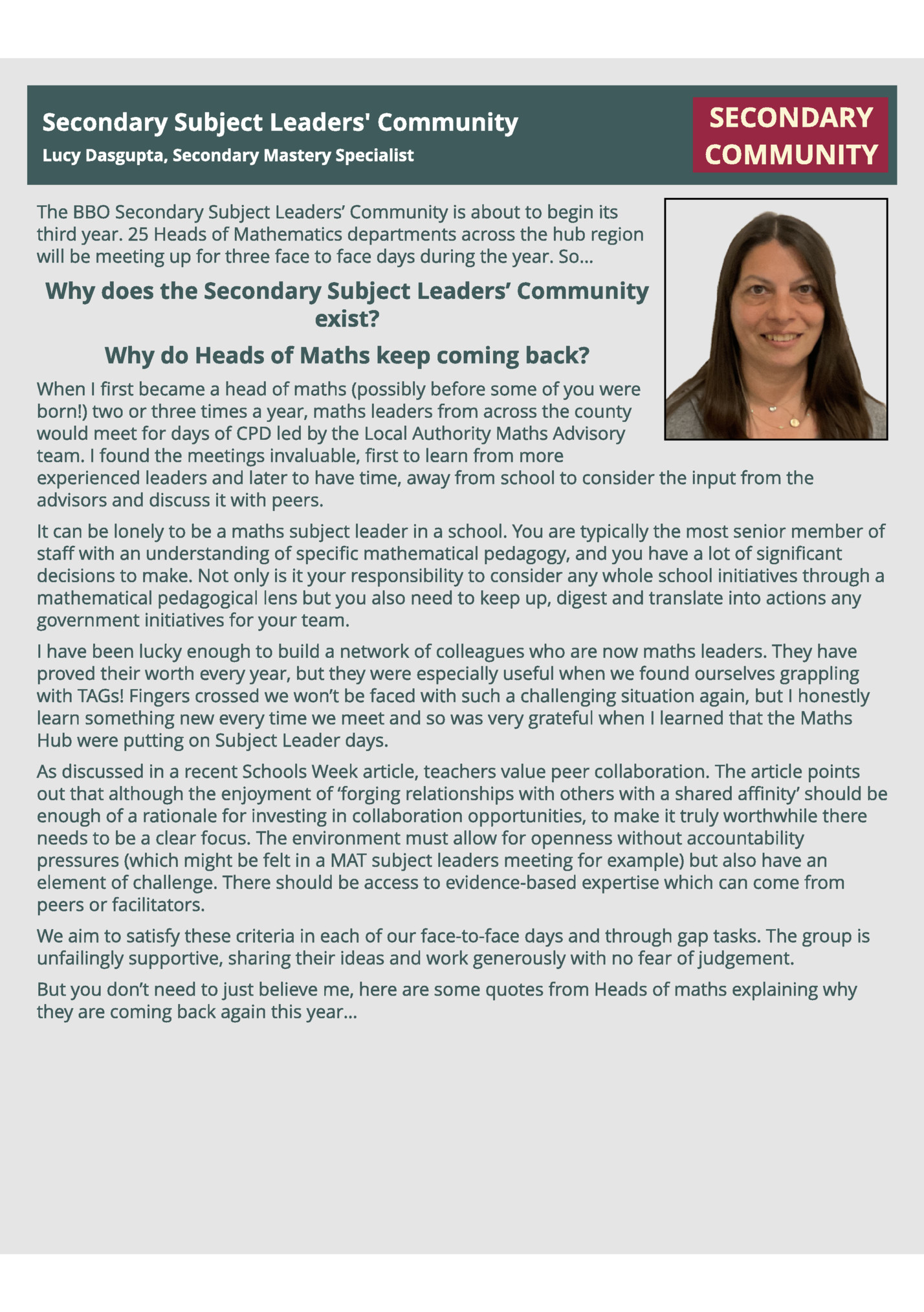
Lu cy Dasgu pt a, Secon dar y M ast er y Specialist SECONDARY COM M UNITY The Secondary Subject Leaders Community has now begun for 2024/25 so if you are a head of department and would like to take part, please complete our registration of interest form for next year and we will be in touch as soon as bookings open for 2025/26.
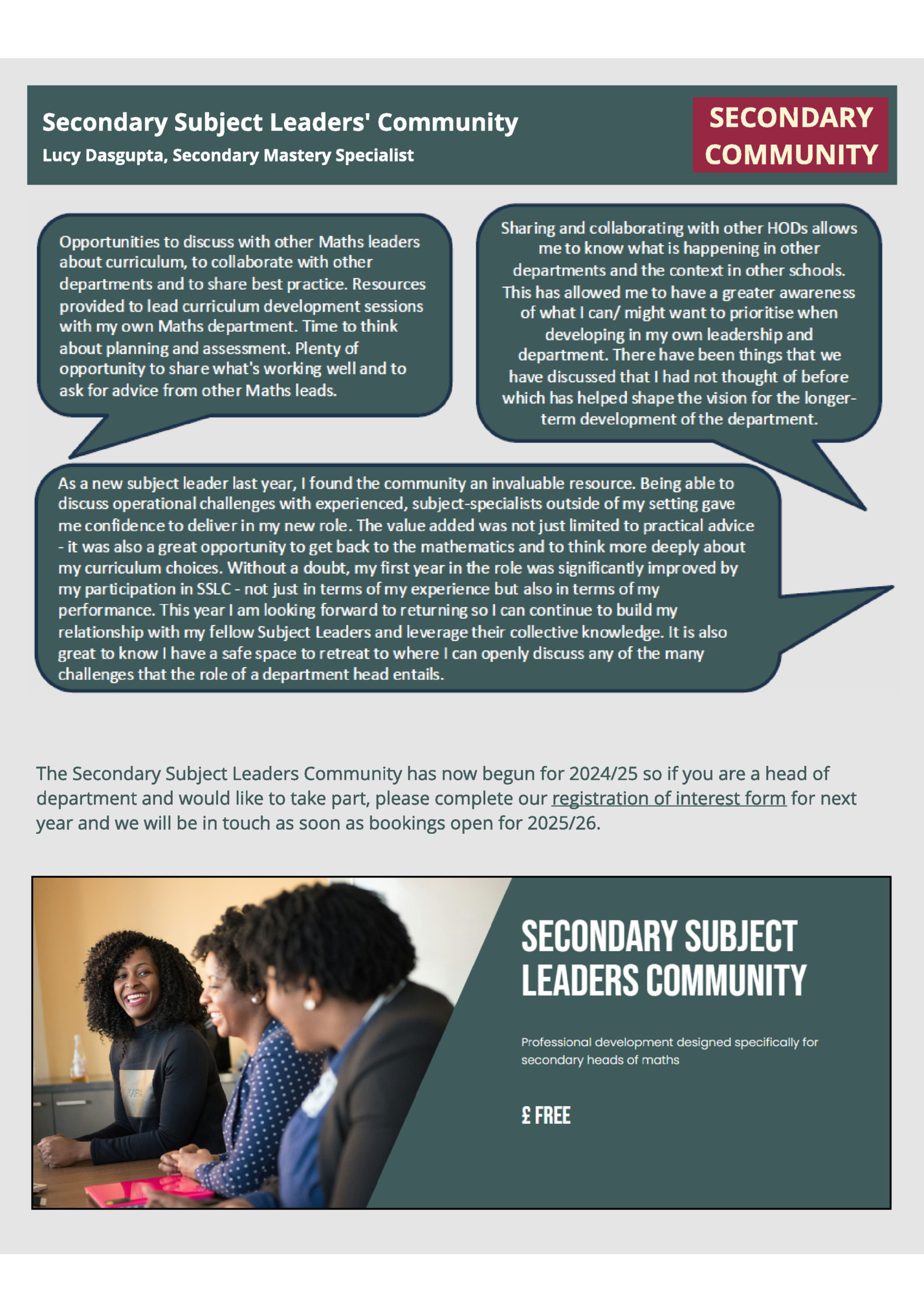
POST 16 Wor k Gr ou p? Dom in ic Bu r k e, Cor e M at h s Specialist Lead, AM SP Wh y Cor e M at h s? One question I am sure is asked in every maths classroom, in every school in the UK is ?When will we ever need this?? Every teacher of Mathematics has their own way of answering this and the class moves on with varying degrees of satisfaction. In Core Maths lessons, teachers don? need a rationale or witty response for their students. Core Maths t develops the skills that every young person can see the relevance of. I believe that all students in Further Education should be offered Core Maths as part of their level 3 provision. If you? looking at this particular re Work Group, you will already know the wide range of benefits to other A levels and Higher Education for a student studying Core Maths. It provides students with the opportunity to address authentic issues and questions using mathematical approaches. Students are encouraged to critically analyse the world around them, evaluate the relevance of solutions in the context of the situation. They will learn how to communicate findings with meaning and accuracy. This qualification contributes to the formation of the student as whole and is much more than the sum of its content. Students will enjoy exploring ethical issues and making sense of the world, and themselves. Wh y join t h e Cor e M at h s Pedagogy Wor k Gr ou p? Whilst visiting schools, teachers in every setting report on a lack of time to design new resources and discuss curriculum with colleagues. This Work Group is an opportunity to collaborate with Core Maths colleagues to discuss ideas, plan and evaluate resources which you can use in the classroom immediately and again with future cohorts. We invite you to be part of an ongoing network of Core Maths support and resource sharing with other professionals. Over a series of five sessions, we will look at the role of mathematical thinking and coherence within Core Maths. Our Work Group will respond to the needs of the participants and create resources which can we used immediately. There will be the opportunity to reflect on these resources and develop them for future use. A Work Group Padlet will be created and shared with participants to ensure a legacy of shared good practice and support. I look forward to welcoming you to the group in 2025. Wh at ot h er t each er s h ave said abou t t h eir par t icipat ion in t h e w or k gr ou p:
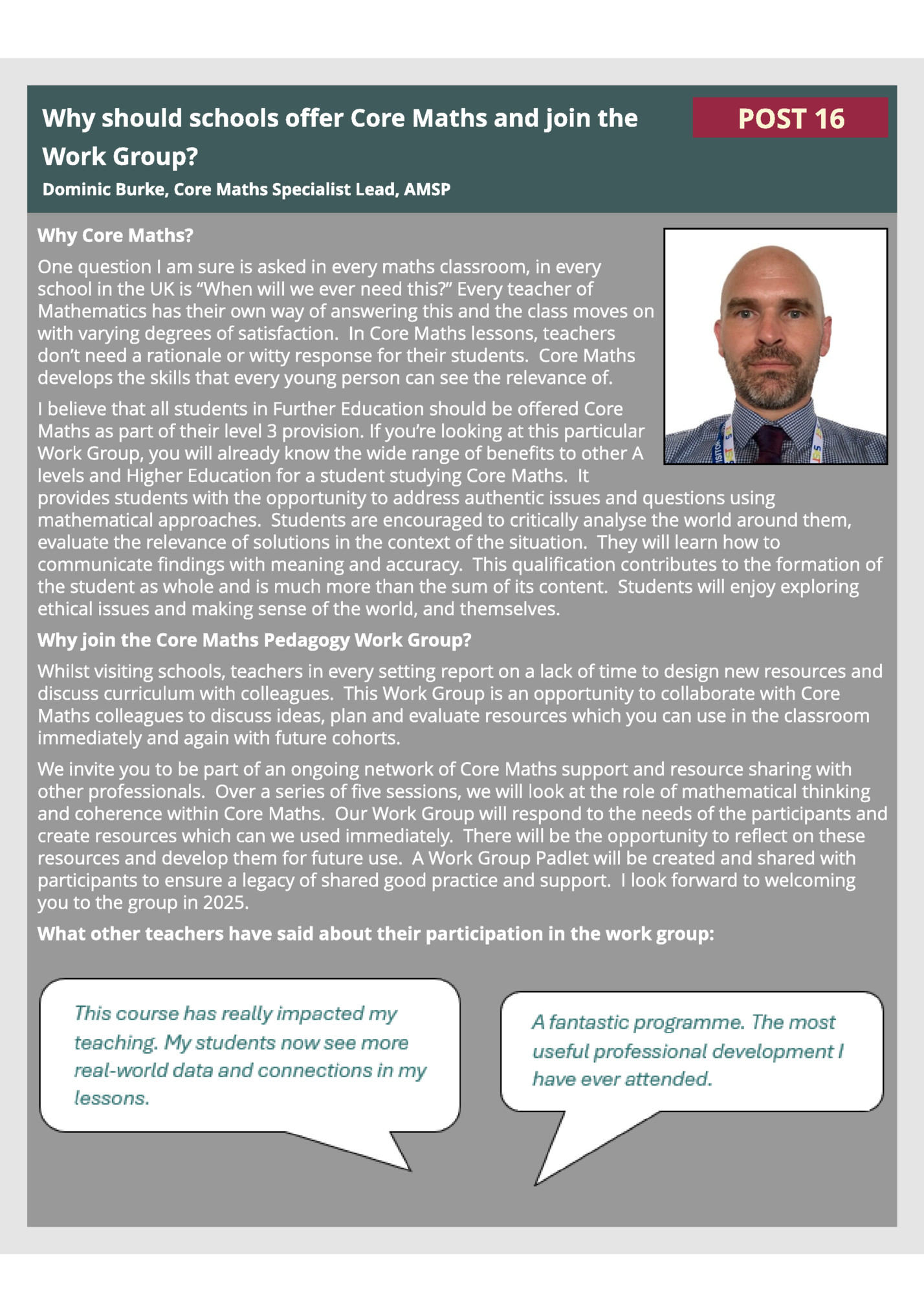
Fleepit Digital © 2021